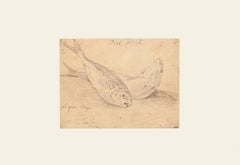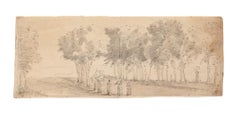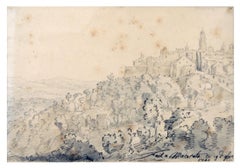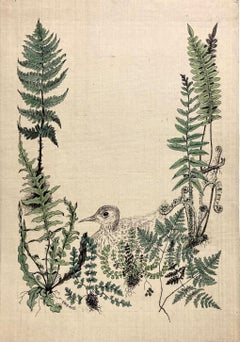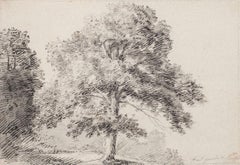Jan Peeter Verdussen Art
to
12
8
8
3
Overall Width
to
Overall Height
to
19
19
7
7
17
2
5
3
3
2
2
1
1
1
1
1
1
1
1
11
11
9
9
1
19
8,244
2,807
1,643
1,319
13
Artist: Jan Peeter Verdussen
St. Gregory in Rome - Original Ink and Watercolor by J. P. Verdussen - 1741
By Jan Peeter Verdussen
Located in Roma, IT
St. Gregory in Rome is a beautiful artwork realized by Jan Peter Verdussen in 1741.
Ink and watercolour on brown paper. In very good codition. Dated on the lower margin. The origin...
Category
1740s Modern Jan Peeter Verdussen Art
Materials
Ink, Watercolor
The Fish - Pencil on Paper by J. P. Verdussen - 1775 ca.
By Jan Peeter Verdussen
Located in Roma, IT
The Fish is a beautiful drawing in pencil on paper realized by Jan Peter Verdussen in 1755 ca.
Hand-signed and dated on the lower in pencil.
In good condition, and aged.
The artwo...
Category
1770s Modern Jan Peeter Verdussen Art
Materials
Pencil
Landscape - Drawing by Jan Peter Verdussen - 1745 ca
By Jan Peeter Verdussen
Located in Roma, IT
Landscape is a beautiful drawing in pencil and watercolor on paper realized by Jan Peter Verdussen in 1745 ca.
In good condition, excpet for some foxing on the right.
The artwork r...
Category
1740s Old Masters Jan Peeter Verdussen Art
Materials
Watercolor, Pencil
$581 Sale Price
25% Off
Landscape - Watercolor and Pencil by Jan Peter Verdussen - 18th Century
By Jan Peeter Verdussen
Located in Roma, IT
Landscape is a beautiful dranwing in watercolor and pencil on ivory-colored paper realized by Jan Peter Verdussen.
In good condition; only a sma...
Category
18th Century Old Masters Jan Peeter Verdussen Art
Materials
Watercolor, Pencil
Landscape - Original Pencil Drawing by J. P. Verdussen - Mid-18th Century
By Jan Peeter Verdussen
Located in Roma, IT
Landscape is an original drawing in pencil on ivory-colored paper realized by Jan Peter Verdussen.
The artwork has some folds rips and foxings and is repaired on the middle line.
T...
Category
Mid-18th Century Modern Jan Peeter Verdussen Art
Materials
Pencil
Vue de Macerata et de sa Campagne - drawing by J. P. Verdussen - 1742
By Jan Peeter Verdussen
Located in Roma, IT
China ink and watercolour on paper.
Some foxing, otherwise very good condition.
Titled and dated.
Includes passepartout.
Category
1740s Jan Peeter Verdussen Art
Materials
Ink, Watercolor
$1,343 Sale Price
25% Off
Landscape - Pencil on Paper by J. P. Verdussen - 18th Century
By Jan Peeter Verdussen
Located in Roma, IT
Landscape is an original drawing is realized by Jan Peter Verdussen.
The artwork has some folds and foxings and is repaired on the middle line.
The artwork represents a landscape.
...
Category
18th Century Modern Jan Peeter Verdussen Art
Materials
Pencil
Rome/Tevere - Pencil and Watercolor Drawing - 1741
By Jan Peeter Verdussen
Located in Roma, IT
Rome is a beautiful artwork realized by Jan Peter Verdussen in 1741.
In good condition except for some pencil marks and traces of sealing wax on the back and some diffused foxings.
...
Category
1740s Old Masters Jan Peeter Verdussen Art
Materials
Watercolor, Pencil
Landscape - Original Pencil on Paper by J. P. Verdussen - 18th Century
By Jan Peeter Verdussen
Located in Roma, IT
Landscape is an original drawing in pencil on ivory-colored paper realized by Jan Peter Verdussen.
The artwork has some folds and foxing and is repair on the middle line.
The artwo...
Category
18th Century Modern Jan Peeter Verdussen Art
Materials
Pencil
Landscape - Pencil Drawing by J. P. Verdussen - Mid-18th Century
By Jan Peeter Verdussen
Located in Roma, IT
Landscape is a beautiful drawing in pencil on ivory-colored paper realized by Jan Peter Verdussen.
The artwork has some folds and foxings. The artwork represents a landscape.
Inclu...
Category
Mid-18th Century Modern Jan Peeter Verdussen Art
Materials
Pencil
Landscape - Sanguine Drawing - 18th Century
By Jan Peeter Verdussen
Located in Roma, IT
Landscape is a beautiful artwork realized by Jan Peter Verdussen.
In good condition.
illegible Hand-signed on the lower right margin.
passepartout included ( 49 x 69 cm).
The artwork represents a landscape river in sanguine drawing...
Category
Early 18th Century Modern Jan Peeter Verdussen Art
Materials
Color Pencil
$716 Sale Price
25% Off
La Campagne de Rome - Roman Countryside - Drawing by J. P. Verdussen - 1740ca
By Jan Peeter Verdussen
Located in Roma, IT
China ink and watercolour on paper.
Realized in 1740 ca.
Very good conditions.
Includes passepartout.
Category
1740s Old Masters Jan Peeter Verdussen Art
Materials
Ink, Watercolor
Ruines Romanes - Roman Ruins - Ink and Watercolor by J. P. Verdussen - 1742
By Jan Peeter Verdussen
Located in Roma, IT
China ink and watercolor on paper.
Hand dated.
Conditions: Foxing on the top right of the paper
Category
1740s Old Masters Jan Peeter Verdussen Art
Materials
Ink, Watercolor
La Bataille - The Battle - Drawing by J. P. Verdussen - 1740s
By Jan Peeter Verdussen
Located in Roma, IT
China ink and watercolor on paper.
Conditions: Two cuts on the centre of the paper. Three holes on centre-right, botton-left and top-left of the paper.
Worn on the top left of the ...
Category
1740s Old Masters Jan Peeter Verdussen Art
Materials
Ink, Watercolor
$1,343 Sale Price
25% Off
The Bridge - Etching - 1745
By Jan Peeter Verdussen
Located in Roma, IT
The Bridge is a beautiful etching artwork realized by Jan Peter Verdussen in 1745.
In good condition except for missing piece of paper and ripping along the margins.
Passepartout i...
Category
1740s Old Masters Jan Peeter Verdussen Art
Materials
Etching
$626 Sale Price
25% Off
The Gardens in Rome - Drawing by J. P. Verdussen - 1741
By Jan Peeter Verdussen
Located in Roma, IT
China ink and watercolour on paper.
Hand dated.
Good condition except for some foxing.
Category
1740s Jan Peeter Verdussen Art
Materials
Ink, Watercolor
$1,074 Sale Price
25% Off
Girl - Ink and Watercolor by J. P. Verdussen - 18th Century
By Jan Peeter Verdussen
Located in Roma, IT
Girl is a china ink drawing realized b Jan Peter Verdussen in the mid-18th Century.
Good condition except for some missing parts in the lower left and right edges.
Category
Mid-18th Century Jan Peeter Verdussen Art
Materials
Ink
The Camp - Ink and Watercolor by J. P. Verdussen - 18th Century
By Jan Peeter Verdussen
Located in Roma, IT
Landscape is a beautiful drawing in pen and watercolor on paper realized by Jan Peter Verdussen.
In aged condition, except for some repaired cut and folding line at the middle.
The...
Category
18th Century Jan Peeter Verdussen Art
Materials
Watercolor, Ink
The Gardens of Rome - Ink and Watercolor by J. P. Verdussen - 1742
By Jan Peeter Verdussen
Located in Roma, IT
China ink and watercolor on paper realized by Jan Peter Verdussen in 1742.
Hand dated.
Conditions: five holes on top margin and on the bottom right of the paper. Foxing on the top ...
Category
1740s Jan Peeter Verdussen Art
Materials
Ink, Watercolor
$1,074 Sale Price
25% Off
Related Items
The Endeavour.
By Arthur John Trevor Briscoe
Located in Storrs, CT
The Endeavour. c.1935. Pencil and watercolor on watercolor board. 14 3/8 x 20 7/8. Signed in pencil, lower right; titled in pencil, verso. Housed in a subtle 23 1/2 x 36-inch light ...
Category
1930s Modern Jan Peeter Verdussen Art
Materials
Pencil, Watercolor
Blanche Grambs, (Young Bird with Ferns)
Located in New York, NY
Blanche Grambs, whose career started with the WPA, was an extremely skilled draftsperson.
Her birds are masterful. This charming piece places the yooun...
Category
1970s American Modern Jan Peeter Verdussen Art
Materials
Pencil
Stone Statue, Madura, India, 1914
Located in Amsterdam, NL
Stone statue in the temple at Madura, India, 1914
Signed with initials top right
Pencil on paper, 21.2 x 16.7 cm
Literature:
Ernst Braches en J.F. Heijbroek, W.O.J. Nieuwenkamp,B...
Category
1910s Art Nouveau Jan Peeter Verdussen Art
Materials
Paper, Pencil
Blanche Grambs, (Young Owl)
Located in New York, NY
Blanche Grambs, whose career started with the WPA, was an extremely skilled draftsperson.
Her birds are masterful. Although we use the word 'pencil' fo...
Category
1970s American Modern Jan Peeter Verdussen Art
Materials
Pencil
Chapel and houses along a lake, New England Landscape - American School, 19th C
Located in Middletown, NY
Watercolor and pencil on buff wove watercolor paper, 10 x 8 inches (255 x 203 mm). In good condition with overall minor toning. Some watercolor paint splatters on the verso, contem...
Category
Early 1900s American Modern Jan Peeter Verdussen Art
Materials
Watercolor, Pencil
Portrait of artist Ida Bagoes Ketut Diding, Bali, 1937
Located in Amsterdam, NL
Ida Bagoes Ketut Diding, Artist on bali 1937
Signed with initials, dated and titled, bottom centre
Black chalk on paper, 29 x 31 cm
Literature:
Ernst Braches en J.F. Heijbroek, W....
Category
1930s Art Nouveau Jan Peeter Verdussen Art
Materials
Paper, Graphite
$23,003
H 11.42 in W 12.21 in D 1.19 in
Glastonbury Abbey
By Frederick Nash
Located in Middletown, NY
Ink wash with watercolor in sepia and black, and blue, on buff wove watercolor paper, 14 1/4 x 10 1/4 inches (360 x 260 mm). 1/4" of the lower right corner is lost, minor crack (doe...
Category
Mid-19th Century English School Jan Peeter Verdussen Art
Materials
Ink, Watercolor, Handmade Paper
Italian neoclassical 19th century Italian figurative drawing antique frieze on paper
Located in Florence, IT
This drawing (pencil, ink and white lead on brown paper, 23 x 19, 5 cm) extremely accurately depicts an image taken from or inspired by antiquity, specifically an acanthus girale in ...
Category
19th Century Other Art Style Jan Peeter Verdussen Art
Materials
Paper, Ink, Pencil, Chalk
$1,551
H 9.06 in W 11.62 in
Cottages in Devon
By Samuel Prout
Located in Middletown, NY
An early Devonshire landscape, ex-collection West Collection of British Watercolors & the Fine Art Society, London.
Circa 1800
Ink and brown wash on paper, 7 1/8 x 10 1/4 inches (...
Category
Early 1800s Realist Jan Peeter Verdussen Art
Materials
Watercolor, Ink, Graphite
[untitled] Street Scene with Fruit Vendor.
By Emilio Sanchez
Located in New York, NY
Emilio Sanchez (1921-1999) created [untitled] “STREET SCENE WITH FRUIT VENDOR” in circa 1950. This unsigned watercolor and came to us directly from the Sanchez estate. It is stamped on the verso "Estate of Emilio Sanchez." This piece is in good to very good condition and painted to the paper's edge. The paper size is 14.88 x 15.25 inches (37.6 x 38.6 cm).
“Best known for his architectural paintings and lithographs, Emilio Sanchez (1921-1999) explored the effects of light and shadow to emphasize the abstract geometry of his subjects. His artwork encompasses his Cuban heritage...
Category
1950s American Modern Jan Peeter Verdussen Art
Materials
Watercolor, Graphite
Children Snow Sledding in Central Park - New Yorker Cover Study
Located in Miami, FL
Hungarian/American artist/illustrator depicts a charming scene of sledding in the snow in Central Park. The work is abstract in its design as it's functional in its narrative - Unpublished New Yorker...
Category
1940s Modern Jan Peeter Verdussen Art
Materials
Charcoal, Ink, Watercolor, Gouache, Pencil
$15,000
H 16.85 in W 12.25 in
Thunderstorm Over Boston
By James McBey
Located in Storrs, CT
Thunderstorm over Boston. July 14, 1930. Ink and watercolor on paper. 10 5/8 x 17 5/8 (sheet 12 x 19 1/4). Signed and dated and titled in ink, lower right; titled verso and annotated...
Category
Mid-20th Century Modern Jan Peeter Verdussen Art
Materials
India Ink, Watercolor
Previously Available Items
Landscape - Pencil and Ink on Paper by J. P. Verdussen - 18th Century
By Jan Peeter Verdussen
Located in Roma, IT
Landscape is a beautiful drawing in pencil and pen on paper realized by Jan Peter Verdussen.
With a description on the lower. " Eseguito in Prossimita d'Nantes"
In good condition.
...
Category
18th Century Modern Jan Peeter Verdussen Art
Materials
Paper, Pencil, Ink
H 9.45 in W 13.78 in D 0.04 in
Battle - Original Pencil Drawing and Watercolor by J. P. Verdussen - 1750 ca.
By Jan Peeter Verdussen
Located in Roma, IT
Battle is an original and unique drawing in pencil and watercolor on paper realized by Jan Peter Verdussen in 1750 ca.
The state of preservation is good except for a hole and aged m...
Category
1750s Jan Peeter Verdussen Art
Materials
Pencil, Watercolor
H 8.27 in W 13 in D 0.04 in
Landscape - Pencil on Paper by Jan Peter Verdussen - Mid-18th Century
By Jan Peeter Verdussen
Located in Roma, IT
Landscape is a beautiful drawing in pencil on paper realized by Jan Peter Verdussen.
In aged condition; with diffused stains and rips plus a small hole.
The artwork represents a tr...
Category
Mid-19th Century Modern Jan Peeter Verdussen Art
Materials
Pencil
H 13.39 in W 11.82 in D 0.04 in
Jan Peeter Verdussen art for sale on 1stDibs.
Find a wide variety of authentic Jan Peeter Verdussen art available for sale on 1stDibs. You can also browse by medium to find art by Jan Peeter Verdussen in pencil, paint, watercolor and more. Much of the original work by this artist or collective was created during the 18th century and is mostly associated with the modern style. Not every interior allows for large Jan Peeter Verdussen art, so small editions measuring 11 inches across are available. Jan Peeter Verdussen art prices can differ depending upon medium, time period and other attributes. On 1stDibs, the price for these items starts at $357 and tops out at $4,178, while the average work can sell for $1,003.

